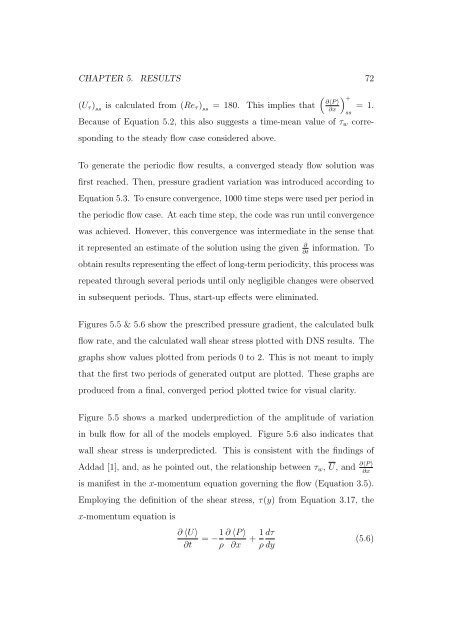The UMIST-N Near-Wall Treatment Applied to Periodic Channel Flow
The UMIST-N Near-Wall Treatment Applied to Periodic Channel Flow
The UMIST-N Near-Wall Treatment Applied to Periodic Channel Flow
Create successful ePaper yourself
Turn your PDF publications into a flip-book with our unique Google optimized e-Paper software.
CHAPTER 5. RESULTS 72<br />
(Uτ) ss is calculated from (Reτ) ss = 180. This implies that<br />
+<br />
∂〈P 〉<br />
∂x<br />
ss<br />
= 1.<br />
Because of Equation 5.2, this also suggests a time-mean value of τw corre-<br />
sponding <strong>to</strong> the steady flow case considered above.<br />
To generate the periodic flow results, a converged steady flow solution was<br />
first reached. <strong>The</strong>n, pressure gradient variation was introduced according <strong>to</strong><br />
Equation 5.3. To ensure convergence, 1000 time steps were used per period in<br />
the periodic flow case. At each time step, the code was run until convergence<br />
was achieved. However, this convergence was intermediate in the sense that<br />
it represented an estimate of the solution using the given ∂<br />
∂t<br />
information. To<br />
obtain results representing the effect of long-term periodicity, this process was<br />
repeated through several periods until only negligible changes were observed<br />
in subsequent periods. Thus, start-up effects were eliminated.<br />
Figures 5.5 & 5.6 show the prescribed pressure gradient, the calculated bulk<br />
flow rate, and the calculated wall shear stress plotted with DNS results. <strong>The</strong><br />
graphs show values plotted from periods 0 <strong>to</strong> 2. This is not meant <strong>to</strong> imply<br />
that the first two periods of generated output are plotted. <strong>The</strong>se graphs are<br />
produced from a final, converged period plotted twice for visual clarity.<br />
Figure 5.5 shows a marked underprediction of the amplitude of variation<br />
in bulk flow for all of the models employed. Figure 5.6 also indicates that<br />
wall shear stress is underpredicted. This is consistent with the findings of<br />
Addad [1], and, as he pointed out, the relationship between τw, U, and<br />
is manifest in the x-momentum equation governing the flow (Equation 3.5).<br />
Employing the definition of the shear stress, τ(y) from Equation 3.17, the<br />
x-momentum equation is<br />
∂ 〈U〉<br />
∂t<br />
∂ 〈P 〉<br />
= −1<br />
ρ ∂x<br />
1 dτ<br />
+<br />
ρ dy<br />
∂〈P 〉<br />
∂x<br />
(5.6)















